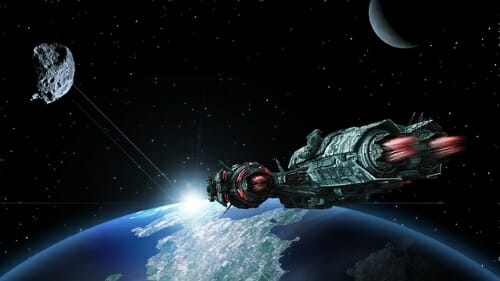Sign up for the
TSL Newsletter
and get $50 off Final Draft 12
By Ken Miyamoto from ScreenCraft · February 13, 2019

The best way for a screenwriter and their screenplays to break through is by reinventing the genres that Hollywood loves to make.
While it may seem as if Hollywood prefers to remake the same concepts over and over again, the truth is that what we see on the big screens is a product of the hot trends over the previous few years. It takes at least a couple of years to get a film into production. And that is usually the result of a screenplay evolving in the development stage for two years or more.
By the time many films make it to theaters, the trends have already worn thin, and audiences have moved on.
So you the screenwriter always need to be ahead of the game. And the way to do that is by pushing your imagination to its limits as you think of ways to reinvent or re-envision the genres that are most profitable and desirable for Hollywood.
Here are five ways that you can jump-start the process of conceptualizing genre reinventions in your screenplays.
Read More: When Genres Collide: The Best (and Weirdest) Movie Genre Mashups
Alien is a conventional monster horror film wrapped up in science fiction — the perfect hybrid.
The Breakfast Club is a character examination piece sold as a teen comedy.
The Twilight Saga films are teen-angst romance stories written under the conceptual umbrella of a vampire movie.
Let the Right One In is a coming-of-age, first-love story functioning as a horror film.
Logan is a superhero movie written within the mythos of a Modern Western.
Baby Driver is a standard heist movie told through both action and music.
Genre hybrids and crossovers are perhaps the easiest way to reinvent or reimagine a genre. You take two genres and their tropes and then mash them together in a way that audiences haven’t seen before.
Cowboys & Aliens is perhaps the most extreme example and it certainly didn’t fare as well as the studio had hoped. But it was a hot property sold on pitch in the late 1990s. It languished in development hell for nearly a decade before Jon Favreau directed it, starring Daniel Craig and Harrison Ford.
While the film wasn’t a huge hit, it’s a perfect example because this is precisely the type of project that Hollywood as a whole gravitates towards.
But the trick is that you have to stay ahead of the game. You can’t copy any of these above examples or any others that have debuted in theaters. You have to think a couple of years ahead of the game.
Maybe we need a romantic comedy set within the realm of science fiction. Maybe we need a car chase movie set within a terrifying horror concept. Whatever your imagination leads to.
Just make it new, different, and exciting.
Most slasher horror movies predominantly involve young, attractive women as the victim to whatever horror has been unleashed upon them. What if you were to take that trope and insert a young man into the equation?
Most sports movies involve a male athlete overcoming impossible odds to become victorious in the end. What if you focused on individual female athletes instead?
We’ve already seen the action genre tackle gender switches well.
James Cameron did it well before anyone else did, with the likes of T2: Judgement Day and Aliens.

Even Meryl Streep took on an action thriller lead in The River Wild.

And we’ve seen female-driven franchises like The Hunger Games and Divergent.
In recent years, we’ve had a welcome — but now somewhat saturated — uprising of female-led action flicks like Lucy, Atomic Blonde, Kidnap, Proud Mary, and Peppermint. Which means that a female-led action flick is currently in need of some reinvention of its own.
Regardless, playing with those conventional genre assignments often found in genres is an excellent way to spin a new kind of tale that Hollywood could find intriguing.
Most westerns are set within the Old West. What if they were set in space (Serenity)?

Changing the conventional location or time period of a genre is a very easy way to spark a compelling concept. Locations can often become intriguing characters in film. They bring about new concepts for the writer to play with and new challenges that can be thrown at the characters. And different time periods mean different types of locations as well.
A few screenwriters have likely attempted Titanic in space (which would mean it’s in the future), but we haven’t seen it in the theaters yet, so maybe there’s time.

That and other examples may not be as strong as we’d like, but the point is to get your creative mind thinking. Remember that Dances with Wolves was unofficially reenvisioned as being set on another planet in the future.
![]()
And The Martian could easily be classified as a partial retelling of Cast Away or Robinson Crusoe — a castaway story set on a different planet in the future.

When you switch those conventional locations and time periods commonly found within certain genres, you enhance the core concept by introducing new challenges and conflicts for the characters. And that engages audiences.
At first glance, a police officer taking on a building full of terrorists could have easily starred action heroes like Sylvester Stallone and Arnold Schwarzenegger — two actors that often portrayed seemingly invincible heroes taking on an endless barrage of bad guys.
These types of protagonists were rarely injured, and if they were shot, they would barely grimace through the pain as they continued on.
And then came John McClane in Die Hard. He was an everyman wisecracker that cried out in pain and outwardly feared for the life of his wife and himself.

This new type of action character reinvented the action genre.
What type of new character can you place within your genre concept?
Television has changed everything. We see a fresh bread of genre storytelling, whether it be science fiction (Westworld), fantasy (Game of Thrones), or horror (The Walking Dead). All three of those genres had previously been more predominant in feature films. But with the addition of the limited series run, we’re watching genre franchise movies being told through the span of ten to twelve hours, with multiple sequels (seasons).
Those three shows, as well as many others, have reimagined and re-envisioned their genres, due in large part to the medium that they were written under.
If you have too much story in your feature script that you’re not willing or able to delete, perhaps you can take that first act and develop it into a hot pilot, while breaking the second and third acts into additional episodes?
One common issue screenwriters have with developing a television series is not having enough story to fill a full season of episodes — let alone multiple seasons. Perhaps you’re better off condensing everything you have into a very tight feature-length spec script?
Take this approach and apply it to a new script. Finish your first draft in five weeks with this free guide.
Hollywood is obsessed with finding projects that are fresh and new, but it’s difficult to do that these days. Everyone is either chasing an already tired trend or writing their versions of their favorite movies that have come before.
Creatively reinventing and reimagining a genre is the fastest way to get your foot in the door as a screenwriter.
It takes time, though. It takes a lot of trial and error to come up with a worthy reinvention. Use these above five ways to help catapult you and your imagination in the right directions.
Ken Miyamoto has worked in the film industry for nearly two decades, most notably as a studio liaison for Sony Studios and then as a script reader and story analyst for Sony Pictures. Make sure to read his growing archive of posts at ScreenCraft for more inspiration.
He has many studio meetings under his belt as a produced screenwriter, meeting with the likes of Sony, Dreamworks, Universal, Disney, Warner Brothers, as well as many production and management companies. He has had a previous development deal with Lionsgate, as well as multiple writing assignments, including the produced miniseries Blackout, starring Anne Heche, Sean Patrick Flanery, Billy Zane, James Brolin, Haylie Duff, Brian Bloom, Eric La Salle, and Bruce Boxleitner. Follow Ken on Twitter @KenMovies
For all the latest from The Script Lab, be sure to follow us on Twitter, Facebook, and Instagram.